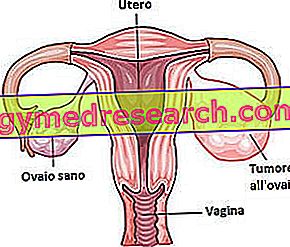Generality
Ovarian cancer, also known as ovarian cancer, is a malignant neoplasm that affects the ovaries, that is, the female gonads.
It is caused by genetic mutations that modify the normal DNA contained in ovarian cells.

The symptoms of ovarian cancer are not very specific and this makes an early diagnosis of the disease more difficult.
Treatment generally consists of surgical removal of the tumor; removal that requires, very often, not only the removal of the ovaries, but also of other organs or tissues (for example the uterus).
Short review on what a tumor is
In medicine, the term tumor identifies a mass of very active cells, able to divide and grow uncontrollably.
- We speak of a benign tumor when the growth of cell mass is not infiltrative (that is, it does not invade the surrounding tissues) and even metastasizing.
- There is talk of a malignant tumor when the abnormal cell mass has the ability to grow very quickly and to spread to the surrounding tissues and the rest of the body.
The terms malignant tumor, cancer and malignant neoplasia are to be considered synonymous.
What is ovarian cancer?
Ovarian cancer - also called ovarian cancer, ovarian cancer or ovarian cancer - is a malignant neoplasm that can occur in any region of the ovary.
WHAT ARE THE OVARIES?
The ovaries (in the singular ovary, but also ovary or ovary ) are the female gonads . The gonads represent a fundamental part of the human reproductive system, since they are the glands that produce the gametes, or the sex cells.
In number of two and similar in shape to a bean, the ovaries perform two functions:
- They secrete female sex hormones ( estrogen and progesterone ), which play an essential role in the development of secondary sexual characteristics and reproduction.
- They produce the egg cell (or oocyte or oocyte ), that is the female gamete. This cell is ripened in the first half of the menstrual cycle, after which it is released from the ovary ( ovulation ) and channeled into the fallopian tubes; in this location, it can possibly be fertilized by a spermatozoon (male gamete).
Each ovary is located on the sides of the uterus . The uterus is the organ of the female genital apparatus appointed to receive and nourish the fertilized egg cell (ie the embryo first and then the fetus then) throughout the pregnancy.

TYPES OF CANCER AT THE OVARIES
The ovaries are made up of cells of different types.
Depending on the type of ovary cells in which it originates, the ovarian tumor takes on a different specific denomination, which refers to the precise location of departure.
Therefore they are distinguished:
- Epithelial-type ovarian cancer (or tumor of the germinal epithelium) . In cases like this, the tumor mass has formed from the epithelial cells that externally cover the ovary. It is by far the most common type of ovarian cancer.
- Germ cell tumor . Germ cells are the cells of the ovaries that give rise to the oocyte. According to some statistical studies, germ cell cancer represents 20% of ovarian tumors and is the most widespread type among girls and young women.
- Stromal ovarian cancer (or tumor on stromal cells of the ovary) . The stromal (or stroma) cells, from which this type of ovarian tumor develops, are cells used to support germ cells and endocrine activity (ie secrete ovarian hormones, testosterone and estrogen). Tumor to stromal cells in the ovary accounts for about 8% of all ovarian cancers.
To complete this classification, it should be remembered that the ovaries can also be the site of tumor metastases from tumors developed elsewhere.
Epidemiology
Ovarian cancer is the fifth most common malignancy among women, after breast cancer, bowel cancer, lung cancer and cancer of the uterus.
The subjects most commonly affected are women who have already passed menopause, so usually over 50 years. However, it should be pointed out that ovarian cancer can occur at any age.
The greatest spread of ovarian cancer occurs among populations of Caucasian origin, in the USA and in north-western Europe.
In Italy: according to an estimate by the Cancer Registry, dating back to 2012, every year ovarian cancer affects just under 4, 500 women.
Causes
Similarly to any other neoplasm, ovarian cancer is also the consequence of a series of genetic mutations affecting the DNA of cells (in this case cells belonging to the ovary, whether epithelial, germinal or stromal).
These mutations - which initially affect only one cell and then all those that derive from it - are responsible for the process of cell division and growth, typical of a neoplasm.
WHAT DETERMINES THE genetic mutations? RISK FACTORS
The precise causes of genetic changes that cause ovarian cancer are unclear.
According to experts, the following conditions / factors would increase the risk of getting ovarian cancer:
- Age over 50 years .
- High number of ovulations . At each ovulation, the ovary suffers a little damage, which is appropriately repaired within a short time. The repair basically consists of a process of cell division, which serves to reconstitute the damaged tissue. According to experts, cell division represents an ideal time for the development of genetic mutations, sometimes deleterious, within DNA.
To support this theory, there are two observations that have not yet been scientifically proven: the first is that women are protagonists of a limited number of ovulations (NB: breastfeeding, taking the contraceptive pill can be the number of ovulations reduced) having so many children etc.) seem less prone to ovarian cancer; the second is that women subjected to infertility treatments (which favor the number of ovulations) seem more predisposed to ovarian cancer.
- Overweight and obesity .
- Follow a hormone replacement therapy . The administration of estrogen and progesterone, in women with reduced production of these hormones, would seem to exert a moderate influence on the development of ovarian cancer.
- Endometriosis . Endometriosis is a disease characterized by the presence of endometrial tissue outside its natural site, which is the uterus.
- Family history of ovarian cancer . Doctors and scientists believe that if a woman has (or had) at least two close relatives (sister, mother or daughter) who carry an ovarian or breast cancer, this same woman is at high risk of developing cancer of the same nature. This risk is linked to a genetic predisposition to the two aforementioned malignancies, which can be transmitted between the various members of the same family. By genetic predisposition to a disease we mean that, in the DNA of a predisposed individual, a dangerous genetic mutation is present from birth.
According to some studies, a family history can only be proven in one out of 10 cases of ovarian cancer.
Family history of ovarian cancer: deepening
The mutated genes that, if inherited, appear to increase the risk of breast and ovarian cancer are the so-called BRCA1 and BRCA2 .
According to experts, a woman is more likely to have a mutation in BRCA1 and BRCA2 if:
- He has (or had) a close relative with ovarian cancer (NB: the age of onset is not important) and at least two other close relatives who have had breast cancer before age 50.
Attention: the relatives referred to must all belong to the same family branch.
- Has (or had) a close relative with ovarian cancer (NB: the age of onset is not important) and at least one other close relative who has breast cancer before age 40.
Attention: the relatives referred to must all belong to the same family branch.
For women with such a family situation, it is advisable to contact your doctor and request information on how to behave.
Symptoms and Complications
To learn more: Symptoms Tumor of the ovary
The symptoms of ovarian cancer are very similar to those caused by other, less serious and more common diseases, such as irritable bowel syndrome, premenstrual syndrome or ovarian cysts .
In light of this, it is questionable how a woman can recognize ovarian cancer in a timely manner and what the most characteristic symptoms are.
Regarding these issues, doctors have observed that the three main (and more frequent) pathological manifestations of an ovarian cancer are:
- A progressive and persistent increase in the size of the abdomen. A swelling that comes and goes is not typical of ovarian cancer.
- Persistent pelvic and abdominal pain.
- Difficulty eating, sense of fullness in the stomach even after a light meal and nausea.
LESS COMMON SYMPTOMS
Although more rarely, ovarian cancer can lead to the following symptoms:
- Back pain
- Loss of appetite
- Need to urinate frequently and urgently
- Pain during sexual intercourse, located in the lower abdomen
- Constipation or diarrhea
- Ascites, ie an accumulation of fluid in the abdominal area, precisely within the peritoneal cavity.
Typically, these disorders are linked to ovarian cancer when they accompany the three main symptoms and when they are subject to continuous deterioration.
WHEN TO REFER TO THE DOCTOR?
If a woman experiences the three most characteristic symptoms of ovarian cancer continuously and persistently, it is a good idea to contact your doctor immediately, for a deeper understanding of the situation.
COMPLICATIONS
A late diagnosis or failure to treat a tumor can lead to the spread of cancer cells ( metastases ) in other organs of the body, which may be those nearby (for example, uterus and / or vagina) or those located in the abdomen and thorax (above all, liver and lymph nodes).
Diagnosis
The earlier ovarian cancer is diagnosed ( early diagnosis ) and the more likely it is that the therapy will be successful.
In general, the diagnostic procedure in case of suspected ovarian cancer involves, first of all, a careful objective examination - during which the doctor evaluates signs and symptoms - and an analysis of the patient's family history ; evaluation of family history is important because it could bring to light a genetic predisposition to ovarian and breast cancers.
After this (and if the risk of ovarian cancer is ever more concrete), the next step is to prescribe a specific blood test for the CA125 tumor marker, an ultrasound of the pelvic organs and a specialist visit to a gynecologist .
ULTRASOUND

Transabdominal ultrasound is a particularly practical exam (the probe is simply passed over the patient's abdomen), but sometimes not very comprehensive.
Transvaginal ultrasound, on the other hand, is a minimally invasive examination (the probe is inserted inside the vagina), but very precise and specific.
BLOOD SPECIFIC EXAMINATION FOR TUMORAL MARKERS CA125 and HE4
The tumor masses formed by a malignant tumor process are characterized by the high presence in the blood of a protein called CA125 . Therefore, with a specific blood test, the physician obtains a measurement of CA125 levels and verifies the exact nature of the mass detected by ultrasonography.
However, it must be pointed out that a high level of CA125 is not always due to a tumor: for example, it can be connected to completely different pathologies, such as endometriosis, pelvic inflammatory disease and tuberculosis .
More recently a new marker of ovarian cancer, HE4, has been introduced, which has proved extremely useful in discriminating between ovarian and cysts or benign ovarian masses. HE4 is in fact more sensitive and specific compared to CA125 and is very useful in the so-called follow-up to detect any recurrences early. The two tumor markers can also be tested jointly.
The doctors resort to the measurement of CA125 and HE4 in the blood following the simultaneous presence of:
- Persistent abdominal swelling
- Persistent sense of fullness in the stomach
- Loss of appetite
- Persistent pelvic and abdominal pain
- Need to urinate frequently and urgently
GYNECOLOGICAL EXAMINATION
During the gynecological examination, the doctor asks the patient to describe the symptoms experienced, analyze the suspected ultrasound or ultrasound scans and finally perform an accurate vaginal examination .
GRAVITY? DEL TUMOR: THE TUMOR STAGES
The severity of a tumor depends on the size of the tumor mass and the diffusion capacity of the neoplastic cells. There are 4 stages of gravity; these stages are distinguished from one another by the first four Roman numerals.
Stage I identifies the least severe tumors, confined to a precise location; Stage IV, on the other hand, identifies the most severe and widespread tumors, even spread in the lymph nodes and other organs of the body (usually the liver). Stages II and III mark tumors of intermediate severity. To learn more, we refer to the general article on tumor staging.
Very often the severity of an ovarian tumor is established only after its surgical removal and after appropriate laboratory tests on cancer cells.
Treatment
To learn more: Drugs for the treatment of ovarian cancer
In general, the presence of an ovarian tumor requires surgical intervention for its removal.
This surgery is the more invasive the larger the tumor mass. In fact, in addition to removing one or both ovaries and Fallopian tubes ( salpingo-oophorectomy ), the surgeon may also be forced to perform:
- The removal of the entire uterus ( total hysterectomy ), if the ovarian tumor is of moderate size and has spread to the nearest organ, or the uterus. Usually, surgeons always resort to hysterectomy, so even when the tumor is small and appears to be confined to the ovaries only. This is due only to precautionary reasons.
- Removal of a part of the omentum ( omentectomy ), if the ovarian tumor is particularly extensive (N: B: the omentum is the serous layer that covers the abdominal cavity).
- The removal (within the limits of the possible) of the abdominal lymph nodes and of all the tissues affected by tumor cells, if the ovarian cancer is stage III or IV.
Usually, after surgery, the patient must also undergo several cycles of chemotherapy (about six). This treatment - which consists of the administration of drugs capable of killing all the rapidly growing cells, including tumoral cells - aims to eliminate any malignant cells that have not been removed by surgery.
To find out more about the most suitable chemotherapy drugs in case of ovarian cancer, the reader is invited to consult the dedicated article on the following page.
The main side effects of chemotherapy
- Nausea
- He retched
- Hair loss
- Sense of fatigue
- Vulnerability to infections
- Lack of appetite
WHAT TO DO IN CASE OF RECIDIVES?
The survival of tumor cells could cause the tumor to reappear in some organ of the body ( recurrence ). In such situations, the planned treatment consists again in a series of chemotherapy cycles.
Prevention
Currently, there is no scientifically reliable screening test that allows a woman's predisposition to ovarian cancer to be known in advance.
Therefore, doctors invite women with a family history and women who have passed the menopause to undergo, at least once a year, a gynecological examination and an ultrasound of the pelvic organs (preferably transvaginal).
Interesting prospects concern the possibility of using the serum HE4 assay as a screening method.
LIFESTYLE
According to the doctors, the risk of developing ovarian cancer is reduced by adopting a healthy lifestyle, therefore eating in a balanced manner, maintaining a normal body weight and practicing constant physical exercise.
Prognosis
If detected early, ovarian cancer can be treated with more than moderate success. In fact, according to an Anglo-Saxon statistic, about 90% of the patients to whom the disease is diagnosed (and obviously cured) are still alive after 5 years of diagnosis.
Unfortunately, the problem of ovarian cancer is that its most common type (germinal epithelial cancer) is difficult to detect in the early stages (even with the most modern diagnostic techniques).
An ovarian cancer diagnosed at an advanced stage almost always has a negative prognosis.



